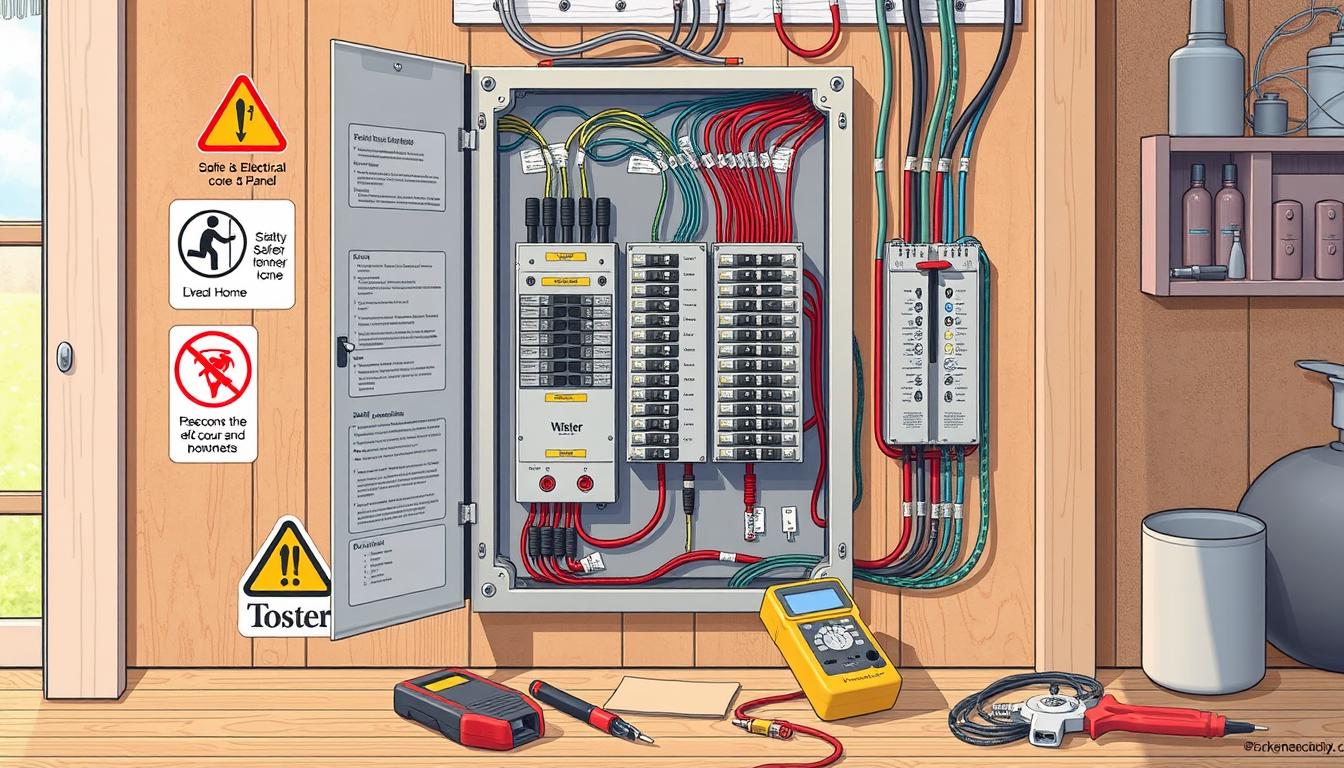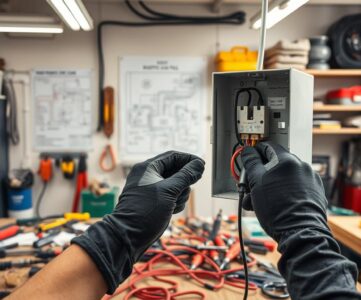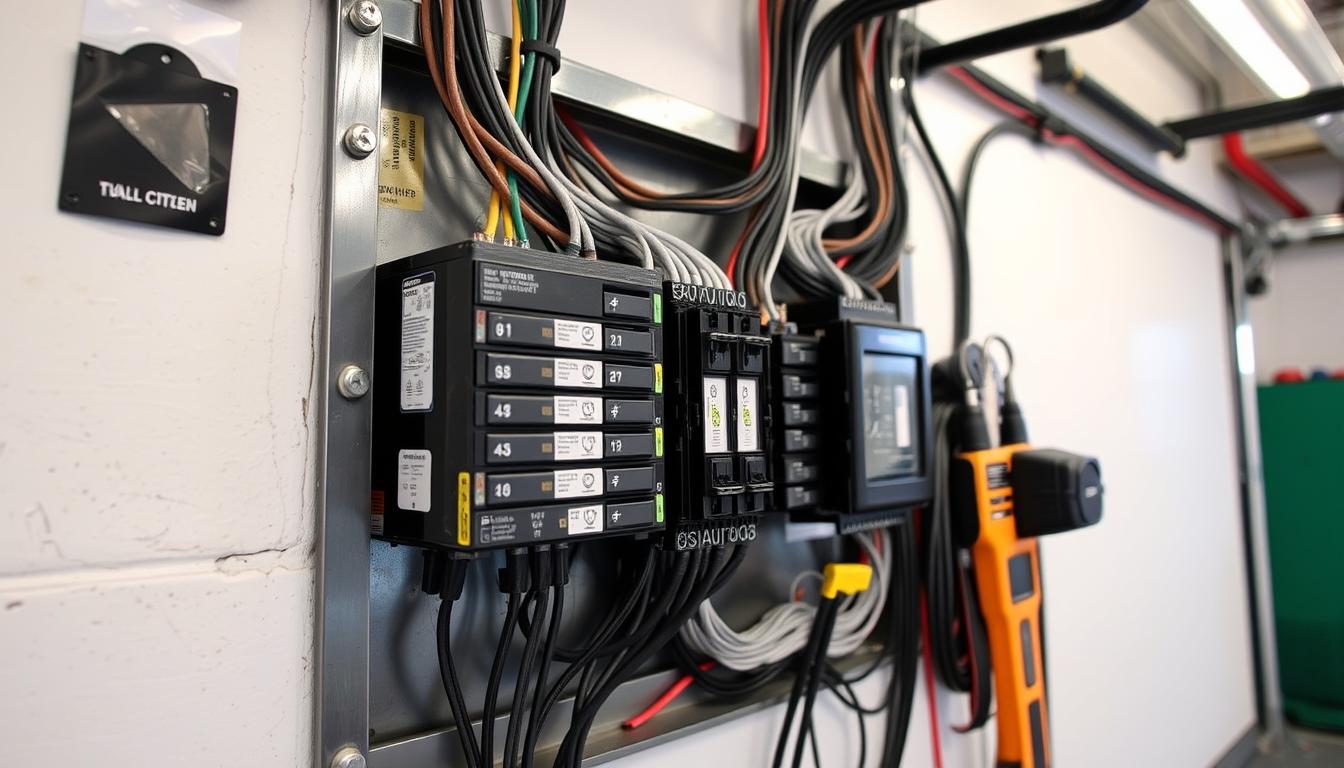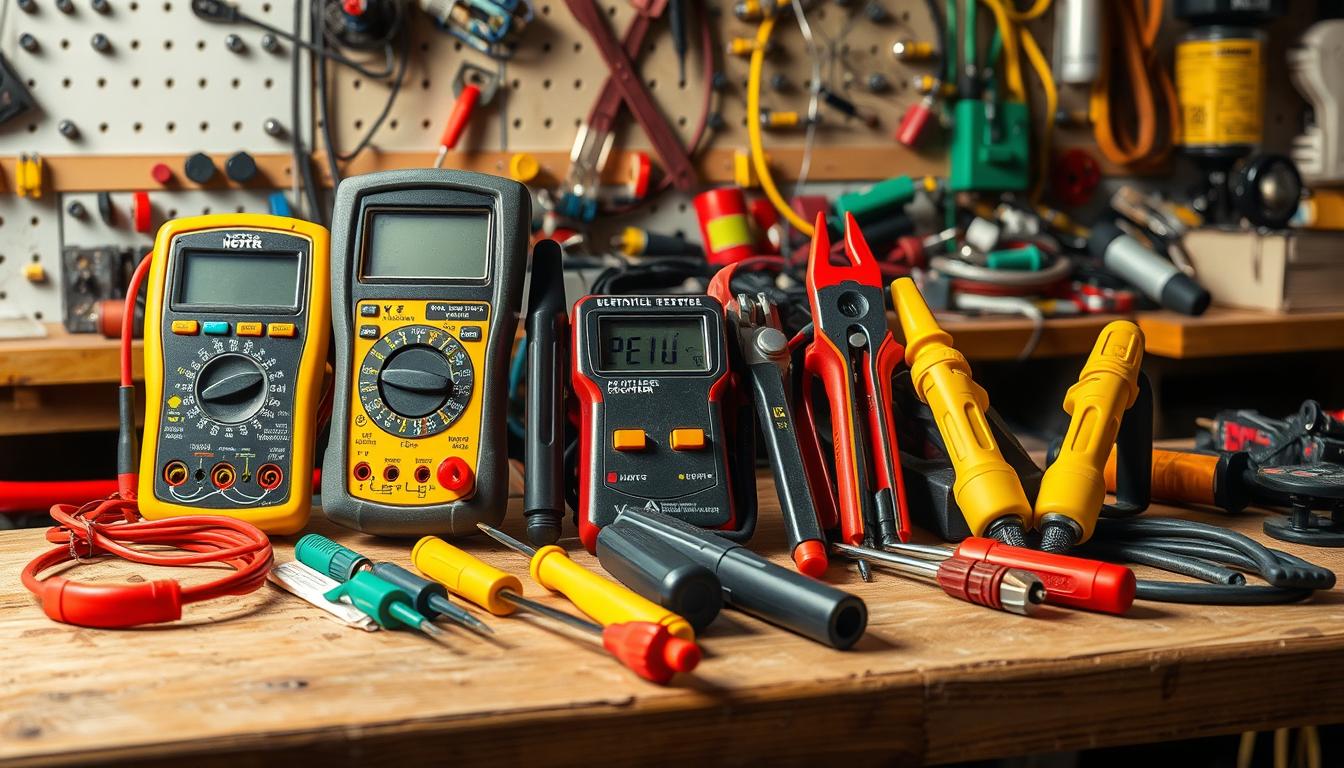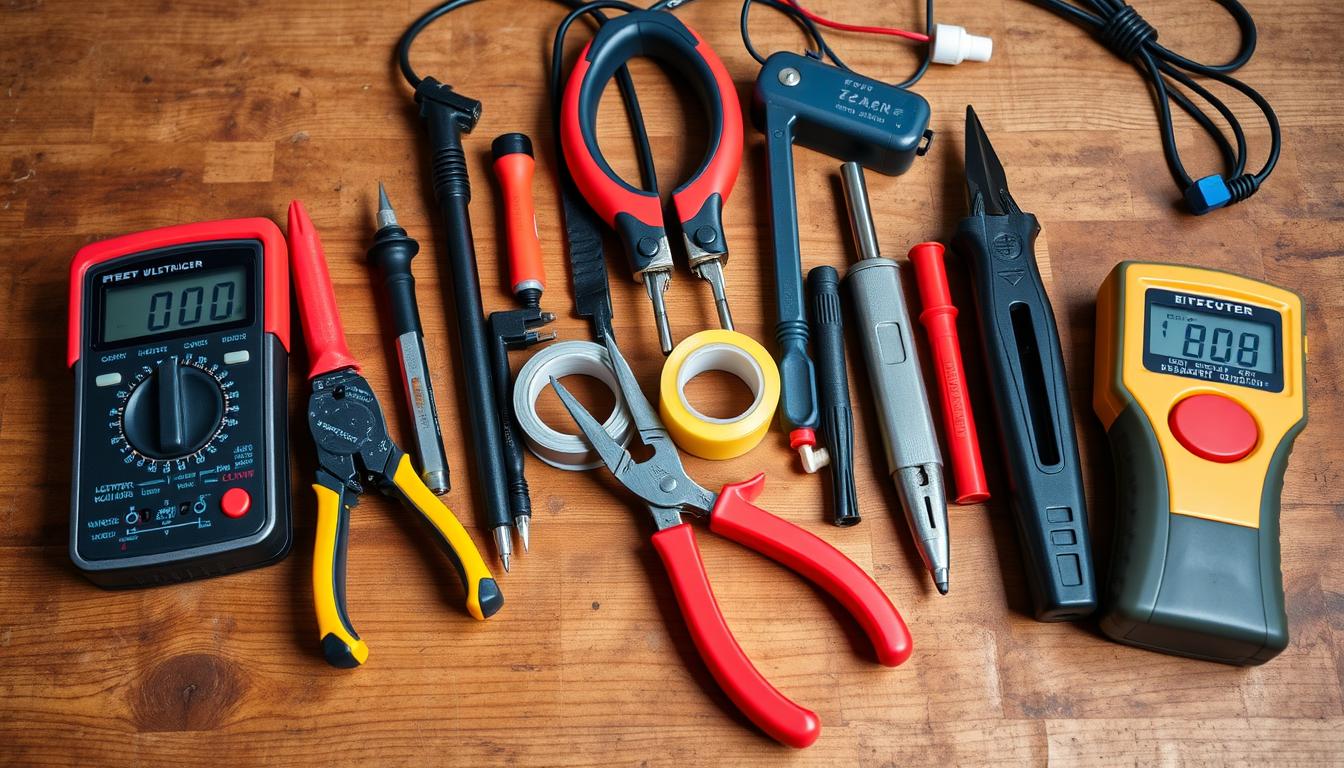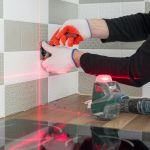DIY home renovations require knowing electrical codes for safety and legal reasons. Homeowners must understand these codes to avoid risks and legal problems. This guide will cover important electrical code aspects, including building codes and standards.
Learning about electrical codes might seem hard, but it’s key for safe DIY projects. Knowing these codes helps you avoid expensive errors and keeps your home safe and legal.
Key Takeaways
- Understanding electrical codes is crucial for DIY home renovations
- Building codes and electrical standards must be met to ensure safety and compliance
- Familiarizing yourself with electrical codes can help avoid costly mistakes
- Electrical codes vary by state and locality, so it’s essential to check local regulations
- Non-compliance with electrical codes can result in legal issues and safety risks
- Staying informed about electrical codes can help homeowners make informed decisions about their DIY projects
Understanding Basic Electrical Code Requirements
When you do DIY electrical work, code compliance is key for safety and to avoid legal trouble. The National Electrical Code (NEC) sets standards for electrical setups. But, remember, these rules can change by state and even locally.
To follow safety regulations, you must know the codes and updates in your area. This means getting familiar with wiring, circuit protection, and grounding rules.
National Electrical Code (NEC) Overview
The NEC is a detailed guide for electrical safety standards. It gets updated every three years to keep up with new tech and best practices.
State-Specific Variations
Even though the NEC is a base, each state has its own changes and updates. These can affect the materials and tools you use in DIY projects.
Local Code Amendments
Local areas also have their own codes and rules. These can be specific to a city or county. They might need extra permits or inspections.
Knowing the basics of electrical codes helps DIY fans make sure their work is safe and legal. This way, they avoid risks and legal problems.
Common DIY Electrical Projects Allowed by Code
It’s key to know what DIY electrical projects are okay by code. This helps avoid risks and legal troubles. Homeowners can do simple tasks like swapping out light fixtures or adding new outlets on their own. But, it’s important to know the permit requirements for these jobs.
Some DIY electrical tasks that are usually okay by code include:
- Replacing existing light fixtures or ceiling fans
- Installing new outlets or switches
- Running new lighting or appliance circuits
Even for these tasks, permit requirements might still be needed. This is true if the project changes the electrical system a lot.
To figure out if a project needs a permit, check local electrical codes or talk to the local building department. Consider these points too:
- Type of project: Is it a simple swap or a bigger installation?
- Scope of work: Does the project make big changes to the electrical system?
- Local regulations: Are there specific permit requirements for DIY electrical work in your area?
Knowing the permit requirements and following local codes ensures DIY electrical work is safe and legal.
Residential Electrical Code Compliance Essentials
Ensuring your home’s electrical system meets local codes is key for safety and passing inspections. Inspection guidelines are crucial for both homeowners and electricians. We’ll cover the main points of electrical code compliance, like wiring, circuit protection, grounding, and outlet placement.
Following inspection guidelines is vital for compliance. These guidelines help identify and fix issues in electrical systems. This ensures your system is safe and works well.
Wiring Requirements
Wiring standards are a big part of electrical code compliance. It’s important that wiring is the right size, insulated, and protected. Inspection guidelines suggest regular checks to make sure wiring meets codes.
Circuit Protection Standards
Circuit protection standards help prevent overloads and short circuits. This means using circuit breakers or fuses that meet local codes. Inspection guidelines help ensure these standards are met, lowering the risk of fires and other dangers.
Grounding Specifications
Grounding is critical for safe electrical system operation. This includes using grounding rods and ensuring all components are grounded. Inspection guidelines recommend checking grounding systems regularly to ensure they comply with codes.
Outlet Placement Rules
Outlet placement rules ensure outlets are safe and convenient. Outlets should be at least 12 inches off the floor and away from water. Inspection guidelines help ensure outlets are placed correctly, reducing shock and other hazards.
| Compliance Aspect | Inspection Guideline |
|---|---|
| Wiring Requirements | Check for proper wiring size, insulation, and protection |
| Circuit Protection Standards | Verify circuit breakers or fuses meet local code requirements |
| Grounding Specifications | Check grounding rods and ensure all components are properly grounded |
| Outlet Placement Rules | Verify outlets are installed at least 12 inches above floor level and avoid water-prone areas |
Safety Standards for Home Electrical Work
Home electrical work needs strict safety standards to avoid accidents and meet legal requirements. Homeowners must follow certain safety steps to keep themselves and others safe. This includes wearing gloves and safety glasses and using the right methods for electrical work.
Being ready for emergencies is also key. Homeowners should have a plan for electrical emergencies. This includes knowing how to turn off power and having a fire extinguisher ready. It’s also important to know the legal requirements for electrical work in your area, as they can differ.
To stay safe and follow legal requirements, homeowners should remember these tips:
- Always turn off the power supply before starting work on an electrical system
- Use proper tools and equipment, such as voltage testers and wire strippers
- Follow manufacturer instructions for electrical devices and materials
By sticking to these safety standards and legal requirements, homeowners can lower the risk of electrical accidents. This ensures a safe and successful DIY project.
Permit Requirements for Electrical Modifications
Understanding the permit requirements for electrical work in your home is key. Building codes and electrical standards guide when you need a permit. Permits are usually needed for new electrical setups, upgrades, or big changes to your current system.
In the U.S., the National Electric Code (NEC) ensures electrical safety. But, local areas might have their own building codes and electrical standards. Always check with your local authorities to know the exact permit needs for your area.
Types of Permits
- Electrical permit: needed for new electrical setups, upgrades, or big changes to the current system.
- Building permit: needed for any construction or renovation that includes electrical changes.
Cost Considerations
The cost of permits varies based on the type, location, and complexity of the work. On average, an electrical permit costs between $50 and $500. Remember to include permit costs in your project budget.
| Permit Type | Cost Range |
|---|---|
| Electrical permit | $50-$500 |
| Building permit | $100-$1,000 |
Prohibited DIY Electrical Work
It’s key to know what DIY electrical projects are okay and what aren’t. Safety rules and codes are there to keep us safe. Some projects are too risky for DIY and can cause harm.
Here are some DIY electrical work you shouldn’t do:
- Working with high-voltage systems
- Installing or modifying electrical panels
- Running new electrical lines or circuits
These tasks need special skills to do right. Not following safety rules can lead to big problems. Always get a pro for tricky electrical jobs.
Also, DIY electrical mistakes can hurt your insurance. Many policies require you to follow safety and code rules. Breaking these can lead to denied claims or losing your policy.
In short, DIY electrical work can save money and teach you new things. But, knowing what’s safe and what’s not is crucial. By being careful, you can stay safe and avoid risks.
| Project | Risk Level | Required Expertise |
|---|---|---|
| Working with high-voltage systems | High | Licensed electrician |
| Installing or modifying electrical panels | High | Licensed electrician |
| Running new electrical lines or circuits | Medium | Experienced DIYer or licensed electrician |
Essential Tools and Safety Equipment
DIY electrical work needs the right tools and safety gear to meet permit requirements and keep you safe. Homeowners should wear gloves, safety glasses, and a hard hat to avoid injuries.
A good toolkit for DIY electrical work includes multimeters and circuit testers. You’ll also need wire strippers, pliers, and screwdrivers. Here’s a list of key tools and safety gear:
- Insulated wire strippers
- Non-contact voltage testers
- Wire nuts and connectors
- GFCI outlets
- Fire extinguisher
Knowing permit requirements and following safety rules is crucial. This way, you can work on DIY electrical projects safely and meet local laws. With the right tools and safety gear, homeowners can finish their projects well and safely.
Always put safety first when working with electricity. By being careful and using the right tools, homeowners can avoid accidents and have a successful DIY electrical project.
| Tool | Description |
|---|---|
| Multimeter | A device used to measure electrical voltage, current, and resistance |
| Circuit tester | A tool used to test for voltage in electrical circuits |
| Wire strippers | A tool used to remove insulation from electrical wires |
Understanding Electrical Inspection Guidelines
Electrical inspection guidelines are key to keeping electrical systems safe and working well. They help spot potential dangers and prevent accidents. By sticking to these guidelines, both homeowners and electricians can make sure electrical setups are done right.
Before an inspection, getting ready with a checklist is a must. This checklist should cover things like:
- Verifying the electrical panel and circuit breakers
- Checking for damaged or worn-out wires and cables
- Ensuring that all electrical outlets and switches are working right
Inspectors will look at the electrical panel, circuit breakers, and wiring. They also check for code violations. Handling these issues quickly is crucial to keep everyone safe.
These guidelines aim to safeguard people and property from electrical dangers. By following them, both homeowners and electricians can ensure electrical systems are safe, efficient, and meet all necessary standards.
Pre-Inspection Checklist
A pre-inspection checklist is a great tool for getting ready for an electrical check. It helps spot potential problems and makes the inspection process smoother and more effective.
Common Inspection Points
Inspectors often check the electrical panel, circuit breakers, and wiring. They also look for signs of wear or damage, like frayed wires or corroded connections.
Dealing with Violations
Handling violations can be tough, but it’s vital to tackle them quickly to avoid safety risks. Homeowners and electricians should work together to find and fix any violations. This ensures electrical systems are safe and follow all necessary codes and standards.
Professional Licensing Requirements
When it comes to electrical work, legal requirements are key for safety and compliance. In the United States, each state has its own rules for electricians. But most states require electricians to have a license to work on electrical systems.
To get a license, electricians must meet certain legal requirements. They need to finish an apprenticeship or have enough work experience. They also have to pass a licensing exam to show they know their stuff.
- Completing an approved apprenticeship program
- Having a certain amount of work experience
- Passing a licensing exam
- Meeting continuing education requirements to maintain licensure
Knowing the legal requirements for electrician licenses helps homeowners. It ensures their electrical work is safe and done right. It also means they’re hiring a qualified pro for the job.
Emergency Electrical Situations and Response
Knowing building codes is key to avoiding electrical emergencies. These emergencies can happen fast, and knowing how to react is crucial. In the U.S., electrical fires and shocks are common. They can be stopped by following building codes.
Spotting hazards is a big part of emergency response. Look out for bad wiring, too many plugs, and damaged gear. By spotting these dangers, you can act fast to stay safe.
Identifying Emergencies
Signs of an electrical emergency include burning smells, sparks, or lights that flicker. It’s important to deal with these quickly to avoid more harm. Knowing building codes helps you spot dangers and act right away.
Immediate Safety Steps
If there’s an electrical emergency, stay calm and act fast. Turn off the power, get out of the area, and call for help if needed. Building codes guide us on how to respond, like using circuit breakers and smoke detectors.
When to Call 911
In serious cases like fires or shocks, call 911 right away. Emergency teams are ready to help. By following building codes and being proactive, we can lower the risk of emergencies and keep places safe.
Documentation and Record Keeping
Keeping good records is key for DIY electrical work. It helps homeowners track their projects and follow electrical standards. They need to keep records of permits, inspections, and any changes to the electrical system.
Having a good record-keeping system saves time and trouble later. It’s important for future projects or inspections. Here are some documents to keep:
- Electrical permits and inspection reports
- Receipts for materials and equipment
- Photos and diagrams of the electrical system
- Notes on any modifications or repairs made
By following electrical standards and keeping accurate records, homeowners can make sure their DIY electrical projects are safe and follow local rules. This gives them peace of mind and helps avoid fines or penalties.
Conclusion: Balancing DIY Projects with Professional Help
When starting home electrical projects, it’s key to find a balance. You should do some tasks yourself but also know when to call a pro. This guide helps with code compliance and safety regulations. But, some jobs are too risky or complex for DIY.
Knowing your limits and keeping your family safe is important. This way, you can handle electrical work at home without risks. It’s all about being smart and careful.
Home electrical systems are complex and need careful handling. It’s tempting to do more DIY, but it’s safer to ask a pro when unsure. Finding the right balance keeps your home’s electrical system safe and up to code.
